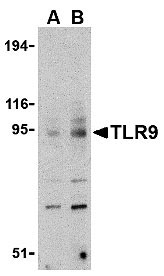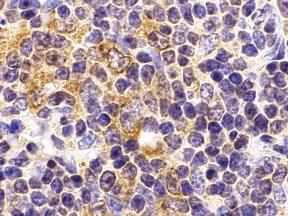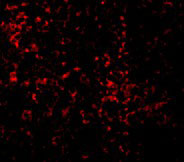TLR9 Antibody
- 产品详情
- 实验流程
- 背景知识
Application
| WB, IF, E, IHC-P |
|---|---|
| Primary Accession | Q9NR96 |
| Other Accession | AAH32713, 21595773 |
| Reactivity | Human, Mouse |
| Host | Rabbit |
| Clonality | Polyclonal |
| Isotype | IgG |
| Calculated MW | 115860 Da |
| Concentration (mg/ml) | 1 mg/mL |
| Conjugate | Unconjugated |
| Application Notes | TLR9 antibody can be used for detection of TLR9 by Western blot at 0.5 to 1 µg/mL. Antibody can also be used for immunohistochemistry starting at 2 µg/mL. For immunofluorescence start at 10 µg/mL. |
| Gene ID | 54106 |
|---|---|
| Other Names | TLR9 Antibody: CD289, Toll-like receptor 9, toll-like receptor 9 |
| Target/Specificity | TLR9; |
| Reconstitution & Storage | TLR9 antibody can be stored at 4℃ for three months and -20℃, stable for up to one year. As with all antibodies care should be taken to avoid repeated freeze thaw cycles. Antibodies should not be exposed to prolonged high temperatures. |
| Precautions | TLR9 Antibody is for research use only and not for use in diagnostic or therapeutic procedures. |
| Name | TLR9 |
|---|---|
| Function | Key component of innate and adaptive immunity. TLRs (Toll- like receptors) control host immune response against pathogens through recognition of molecular patterns specific to microorganisms. TLR9 is a nucleotide-sensing TLR which is activated by unmethylated cytidine- phosphate-guanosine (CpG) dinucleotides (PubMed:14716310). Acts via MYD88 and TRAF6, leading to NF-kappa-B activation, cytokine secretion and the inflammatory response (PubMed:11564765, PubMed:17932028). Controls lymphocyte response to Helicobacter infection (By similarity). Upon CpG stimulation, induces B-cell proliferation, activation, survival and antibody production (PubMed:23857366). |
| Cellular Location | Endoplasmic reticulum membrane; Single-pass type I membrane protein {ECO:0000250|UniProtKB:Q9EQU3}. Early endosome membrane. Lysosome {ECO:0000250|UniProtKB:Q9EQU3} Cytoplasmic vesicle, phagosome {ECO:0000250|UniProtKB:Q9EQU3}. Golgi apparatus membrane. Note=Relocalizes from endoplasmic reticulum to endosome and lysosome upon stimulation with agonist. Exit from the ER requires UNC93B1. Endolysosomal localization is required for proteolytic cleavage and subsequent activation Intracellular localization of the active receptor may prevent from responding to self nucleic acid. {ECO:0000250|UniProtKB:Q9EQU3, ECO:0000269|PubMed:14716310, ECO:0000269|PubMed:38169466} |
| Tissue Location | Highly expressed in spleen, lymph node, tonsil and peripheral blood leukocytes, especially in plasmacytoid pre-dendritic cells. Levels are much lower in monocytes and CD11c+ immature dendritic cells. Also detected in lung and liver |
For Research Use Only. Not For Use In Diagnostic Procedures.
Provided below are standard protocols that you may find useful for product applications.
BACKGROUND
TLR9 Antibody: Toll-like receptors (TLRs) are evolutionarily conserved pattern-recognition molecules resembling the toll proteins that mediate antimicrobial responses in Drosophila. These proteins recognize different microbial products during infection and serve as an important link between the innate and adaptive immune responses. TLR9 forms a subfamily along with TLR7 and TLR8 that recognize viral RNA and CpG DNA sequences and are localized in intracellular acidic compartments such as the phagolysosome. Unlike other TLRs which act through adaptor molecules such as TOLLIP, TIRAP, TRIF, and MyD88 to activate various kinases and transcription factors to respond to potential infection, TLR9 is strictly dependent on MyD88.
REFERENCES
Takeda K, Kaisho T, and Akira S. Toll-like receptors. Annu. Rev. Immunol. 2003; 21:335-76.
Janeway CA Jr. and Medzhitov R. Innate immune recognition. Annu. Rev. Immunol. 2002; 20:197-216.
Wagner H. The immunobiology of the TLR9 subfamily. Trends Immunol. 2004; 381-6
Nishiya T and DeFranco AL. Ligand-regulated chimeric receptor approach reveals distinctive subcellular localization and signaling properties of the Toll-like receptors. J. Biol. Chem. 2004; 279:19008-17.
终于等到您。ABCEPTA(百远生物)抗体产品。
点击下方“我要评价 ”按钮提交您的反馈信息,您的反馈和评价是我们最宝贵的财富之一,
我们将在1-3个工作日内处理您的反馈信息。
如有疑问,联系:0512-88856768 tech-china@abcepta.com.























 癌症的基本特征包括细胞增殖、血管生成、迁移、凋亡逃避机制和细胞永生等。找到癌症发生过程中这些通路的关键标记物和对应的抗体用于检测至关重要。
癌症的基本特征包括细胞增殖、血管生成、迁移、凋亡逃避机制和细胞永生等。找到癌症发生过程中这些通路的关键标记物和对应的抗体用于检测至关重要。 为您推荐一个泛素化位点预测神器——泛素化分析工具,可以为您的蛋白的泛素化位点作出预测和评分。
为您推荐一个泛素化位点预测神器——泛素化分析工具,可以为您的蛋白的泛素化位点作出预测和评分。 细胞自噬受体图形绘图工具为你的蛋白的细胞受体结合位点作出预测和评分,识别结合到自噬通路中的蛋白是非常重要的,便于让我们理解自噬在正常生理、病理过程中的作用,如发育、细胞分化、神经退化性疾病、压力条件下、感染和癌症。
细胞自噬受体图形绘图工具为你的蛋白的细胞受体结合位点作出预测和评分,识别结合到自噬通路中的蛋白是非常重要的,便于让我们理解自噬在正常生理、病理过程中的作用,如发育、细胞分化、神经退化性疾病、压力条件下、感染和癌症。








